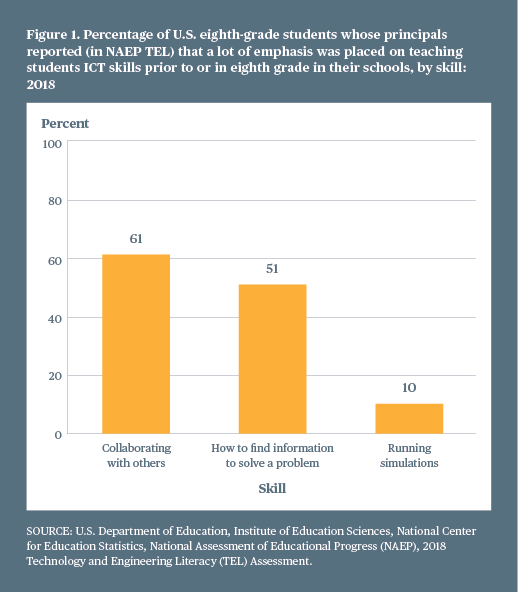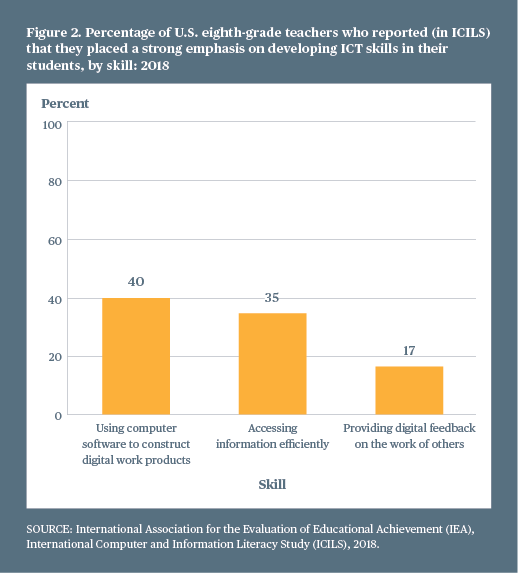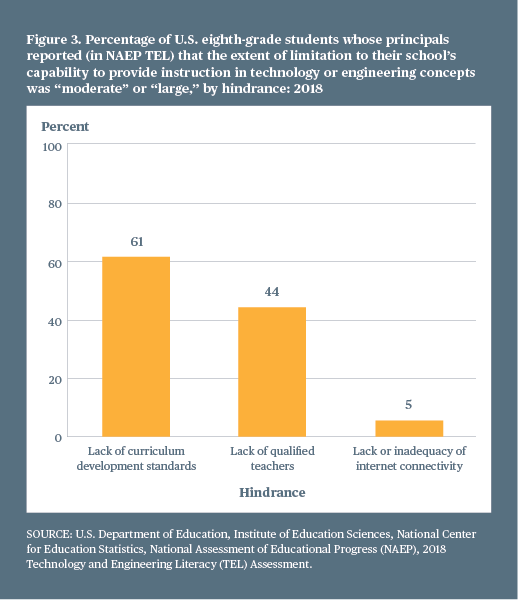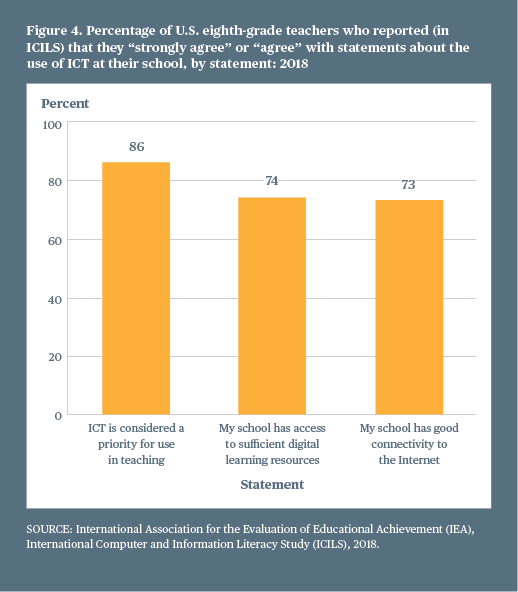
As schools and school districts plan instruction amid the current coronavirus pandemic, the use of technology and digital resources for student instruction is a key consideration.
In this post, the final in a three-part series, we present results from the NAEP TEL and ICILS educator questionnaires (see the first post for information about the results of the two assessments and the second post for the results of the student questionnaires). The questionnaires ask about the focus of technology instruction in schools, school resources to support technology instruction, and the use of technology in teaching practices.
It is important to note that NAEP TEL surveys the principals of U.S. eighth-grade students, while ICILS surveys a nationally representative sample of U.S. eighth-grade teachers.
Emphasis in technology instruction
According to the 2018 NAEP TEL principal questionnaire results, principals1 of 61 percent of U.S. eighth-grade students reported that prior to or in eighth grade, much of the emphasis in information and communication technologies (ICT) instruction was placed on teaching students how to collaborate with others. In addition, principals of 51 percent of eighth-grade students reported that a lot of emphasis was placed on teaching students how to find information or data to solve a problem. In comparison, principals of only 10 percent of eighth-grade students reported that a lot of emphasis was placed on teaching students how to run simulations (figure 1).

According to the 2018 ICILS teacher questionnaire results, 40 percent of U.S. eighth-grade teachers reported a strong emphasis on the use of ICT instruction to develop students’ capacities to use computer software to construct digital work products (e.g., presentations). In addition, 35 percent of eighth-grade teachers reported a strong emphasis on building students’ capacities to access online information efficiently. In comparison, 17 percent reported a strong emphasis on developing students’ capacities to provide digital feedback on the work of others (figure 2).

Resources at school
NAEP TEL and ICILS used different approaches to collect information about technology-related school resources. NAEP TEL asked about hindrances that limited schools’ capabilities to provide instruction in technology or engineering concepts. According to NAEP TEL, principals of 5 percent of U.S. eighth-grade students indicated that a lack or inadequacy of internet connectivity was a “moderate” or “large” hindrance in their schools. However, principals of 61 percent of eighth-grade students indicated that a lack of time due to curriculum content demands was a “moderate” or “large” hindrance. Principals of 44 percent of eighth-grade students indicated that a lack of qualified teachers was a “moderate” or “large” hindrance (figure 3).

ICILS asked about the adequacy of school resources to support ICT use in teaching. Eighty-six percent of U.S. teachers “agreed” or “strongly agreed” that technology was considered a priority for use in teaching. Nearly three-quarters of teachers “agreed” or “strongly agreed” that their schools had access to sufficient digital learning resources and had good internet connectivity (74 and 73 percent, respectively) (figure 4).

Use of technology in teaching
Teachers of U.S. eighth-grade students reported that they often used technology in their teaching practices. ICILS found that 64 percent of U.S. teachers regularly (i.e., “often” or “always”) used technology to present class instruction. Fifty-four percent of teachers regularly used technology to communicate with parents or guardians about students’ learning. In addition, 45 percent of teachers regularly used technology to provide remedial or enrichment support to individual or small groups of students, and a similar percentage (44 percent) regularly used technology to reinforce skills through repetition of examples (figure 5).

ICILS also reported results from U.S. eighth-grade teachers about how they collaborated on technology use. About three-quarters “agreed” or “strongly agreed” that they talked to other teachers about how to use technology in their teaching. Similarly, about three-quarters “agreed” or “strongly agreed” that they shared technology resources with other teachers in the school. More than half of the teachers “agreed” or “strongly agreed” that they collaborated with colleagues on the development of technology-based lessons.
Overall, the responses of teachers and principals suggested that emphasis had been put on different aspects of instruction for eighth-grade students. The majority of schools had enough digital resources and adequate internet access. However, technologies were also used differently in different teaching practices.
It should be noted that the data presented here were collected in 2018; any changes since then due to the coronavirus pandemic are not reflected in the results reported here. The NAEP TEL and ICILS samples both include public and private schools. The 2018 ICILS also included a principal questionnaire, but the questions are not directly related to the topics included in this blog. Data reported in the text and figures are rounded to the nearest integer.
Resources for more information:
By Yan Wang, AIR, and Taslima Rahman, NCES
[1] The unit of analysis for TEL principal responses is student.